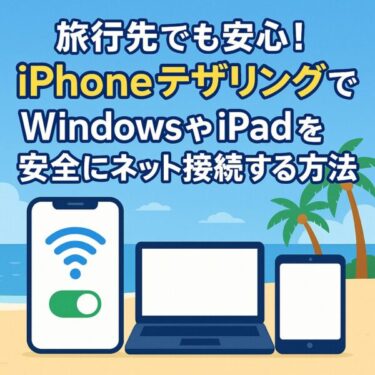![iPhone Tethering for Secure Internet on Windows and iPad – A Traveler’s Guide [2025 Edition] 1 Flat-style illustration showing an iPhone, a Windows laptop, and an iPad connected via secure Wi-Fi tethering, with the title "iPhone Tethering for Secure Internet on Windows and iPad" above them.](https://kimiyoya.com/wp-content/uploads/2025/08/1A04D69C-CCD8-4968-96D4-726397D90FF4.jpg)
Planning to use your laptop or iPad while traveling? Free public Wi-Fi may seem convenient, but it often comes with serious security risks. From data theft to fake access points, it’s easier than you think to fall victim to cyber threats while connected to an unsecured network.
That’s why iPhone tethering is the smarter and safer alternative.
In this guide, we’ll explain how to share your iPhone’s internet with your Windows PC or iPad—securely, reliably, and without the headaches of public Wi-Fi.
Why Public Wi-Fi Is Risky
- No encryption means your data can be intercepted
- Fake hotspots can trick your device into connecting
- Shared networks = shared vulnerabilities
When you tether, you control the connection—no unknown devices, no open networks, no surprises.
Why iPhone Tethering Is Safer
- Encrypted connection (WPA2 or higher)
- Password-protected access
- Only your devices connect—no strangers
Tethering turns your iPhone into a personal Wi-Fi hotspot. It’s ideal for travelers, digital nomads, and remote workers who need a secure connection anywhere.
3 Ways to Tether Your iPhone
You can tether your iPhone to a Windows PC or iPad using three methods:
| Method | How It Works | Stability | Best Use Case |
|---|---|---|---|
| 1. Wi-Fi | Connect wirelessly using your iPhone’s hotspot | Good | Quick setups at cafés, hotels, or airports |
| 2. USB | Connect via Lightning cable for a wired connection | Excellent | Stable work sessions; charge while connected |
| 3. Bluetooth | Low-power wireless option | Fair | Light use like email or messaging |
Choose the method that suits your situation best. USB is ideal for long sessions, while Wi-Fi is great for flexibility.
If you’re using USB tethering, make sure to use a reliable MFi-certified Lightning cable for stable data transfer and safe charging.
▶ View top-rated Lightning cables on Amazon
This article contains affiliate links. If you purchase through them, we may earn a small commission at no additional cost to you. Thank you for your support!
When Tethering Comes in Handy
- Hotel Wi-Fi is slow or not working
- You’re working from a café or shared space
- You’re on a train or traveling by car
- Your home internet suddenly goes down
Important Tips for Safe Tethering
- Turn off tethering when not in use
- Use a strong Wi-Fi password
- Monitor data usage—tethering can consume a lot
- Carry a power bank to avoid battery drain
Tethering is powerful, but managing it smartly ensures you stay both connected and protected.
Common Questions (FAQ)
Q. Does tethering cost extra?
Most carriers include tethering in data plans, but check your contract to avoid surprises.
Q. Can I take phone calls while tethering?
Yes! Though depending on your carrier, your data might pause during a call.
Q. How much data does tethering use?
Browsing uses around 100–150MB/hour. Streaming HD videos can use 1GB/hour or more.
Worried About Data Usage?
If you plan to tether regularly, consider switching to an unlimited or high-data plan like Rakuten Mobile in Japan or similar international options. No throttling, no extra fees—just worry-free tethering.
▶ Read the full Japanese article here (with visuals)
Conclusion
Public Wi-Fi might be free, but it’s rarely secure. iPhone tethering offers a safer, more reliable solution—especially when you’re on the go. Whether you’re working remotely or just browsing while traveling, take control of your connection with your own device.
✔️You might also find these helpful:
▶︎How to Use Public Wi-Fi Safely Without a VPN
▶︎How to Fix “No Internet Access” on Windows
▶︎WSUS Clients Not Updating? Common Causes and How to Fix Them
▶︎Unlock Windows God Mode: Access All Settings in One Place
▶︎Wi-Fi Connected but No Internet? Here’s How to Fix It on Windows
💡 Looking for more tips? Check out our full list of Windows Help Guides.


